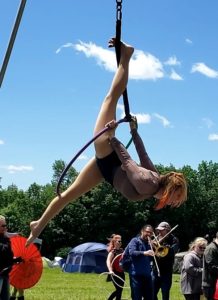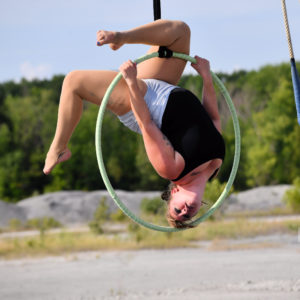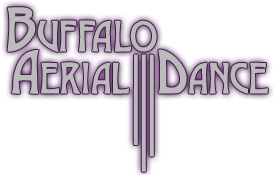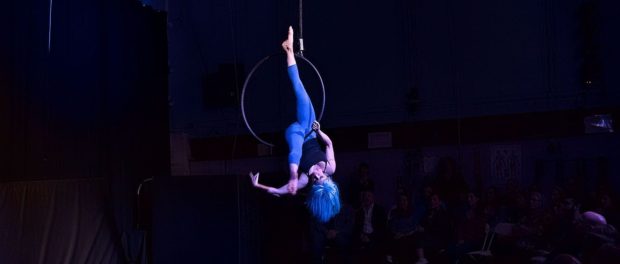Hooping it Up: A closer look at the Lyra
Lyra is a such pleasure to watch. Those beautiful, spinning shapes appear effortless and full of magic. Achieving that magic involves lots of hard work, lots of strength and flexibility, and lots of refining details. But it’s also very rewarding to see your lyra goals come to life.

Erica performing on lyra at a Slyboots Circus event
For almost a decade I was obsessed with silks, and trained rope and trapeze here and there, but rarely set foot on a hoop. In 2016, the studio’s original lyra teacher moved away, leaving behind a big demand for aerial hoop classes that I was somehow supposed to fill. I started driving to Toronto for private lessons, and spent a lot of time experimenting on lyra in the studio. I also watched many lyra videos on social media, many, many videos. To be clear, trying to learn aerial skills from Instagram is definitely frowned upon for many reasons that I won’t get into here, but there are also ways to use social media constructively. As I watched, I gathered data about this mysterious apparatus, trying to understand the different ways to approach it.
Lyra is often categorized into dynamic style and flow style, which is a great starting point, but I wanted to know more. I tried to put what I saw into words. Aerial definitions are always a little imperfect, but they can be a good tool. Here’s my version of some definitions. They are not at all official.
Dynamic Lyra – Lyra moves where you release from the bar, such as drops, and moves that use momentum, such as many types of beats. Dynamic lyra is often done on a high hoop to allow swings under the bar and dramatic dismounts. It is more of a gymnastic or acrobatic style, and generally does not spin.
Flow Lyra – Lyra sequences made up of a series of poses connected with smooth transitions. Flow lyra is often done on a low or medium height hoop so the aerialist can create spin as they enter the hoop, but it can be done on any height, or pulleys can be used to raise the aerialists once they mount the hoop. It is more of a dance-based style.
Spinny Lyra – A style based on achieving a high speed spin, usually with simple poses and very deliberate transitions. Certain poses are strategically used to change thew speed of the rotation, varying the spin from a little slower to tornado speed.
Contortion Lyra – This style involves many common poses that are exaggerated to showcase extreme flexibility. Should only be done with a coach who is trained to coach contortion.
Weaving/Threading – A popular approach to creating transitions often used in flow lyra, but could also be considered its own style. Threading and weaving involve gliding a limb through an open space on the hoop to move into a new shape.
Explorations (also sometimes call play, like “spanset play”) – Playful research focused on as adding as much variety as possible to single element such as an elbow hang or a back balance.

Rebecca performing on lyra at Penn Dixie Fossil Farm
If you’ve ever taken a lyra class with me, you already know that my heart is in flow lyra. B.A.D. lyra classes lean heavily in that direction, with a little bit of everything else, except contortion, mixed in. I’m not a contortionist by any stretch (pun intended) so I don’t teach that. There are a few dynamic moves that I do teach, but I don’t have a ton of background in that style either. The spinny style is a skill set I would like to master and we do work on that a bit too. I come from a dance background, so flowy lyra felt the most natural to me, and I love that it can be very expressive. Here’s a video that shows a short flow with a few dynamic moves, and a slow spin: video.
Focusing on flow sequences also revealed what I really love about the aerial hoop. It frames bodies and shapes so beautifully, but also, it leaves nowhere to hide. You have to recognize that every little movement counts. When watching a lyra sequence, I love noticing a pose or transition that’s familiar, but done with new variations. These little variations always remind me how many new possibilities exist within the moves I had previously checked off as “done.” I’ve since stopped checking off any move. They are never carved in stone and we can always revisit and reshape them according to the impressions we want to create.

Colleen performing lyra at a student showcase
As great as flows are, when you try to make them into art, they can be pretty frustrating! Maybe you keep unintentionally moving your hand in a weird way or can’t figure out how to smooth out a transition, it’s a process that brings out the perfectionist is all of us. If the frustration is getting the best of you, lyra also gives you an option to hit the pause button and work on something that’s just plain fun instead. For me lately, that’s been hip circles. I know y’all don’t feel the same way about those, but I definitely encourage you to find a few go-to fun moves for when you need a dose of happy. One of my favorite aerialists, the lovely Shannon Gray, once said to me that she focuses on moves that just feel really good to her, and digs as deep as she can into that goodness. Those moves and that goodness can be quite different for all of us, and that’s amazing. I’m digging up all the lyra goodness that I can at the moment, and I hoop you will too. 😉
Current lyra classes at Buffalo Aerial Dance
- Lyra Intro Series (3 classes) October 8, 15, 22 2:30-3:45 Sign up here
- Level 1 -2 Lyra (Drop in) Saturdays at 1:00 Sign up here
- Level 2-3 Lyra (Drop in) Wednesdays at 6:45 Sign up here

